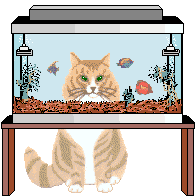Gardening Advice for a Big Brown Thumb
 |
Hi, Anne
Miniature roses need at least four hours of direct sunlight each day, as well as moderate humidity and fresh air during their active growing season. They also will do very well when grown under flourescent 'grow' lights. Temperature range should be between 60 and 70 degrees F. Do not use to large of a pot, a 4-5 inch pot is plenty big enough. The soil should be kept moist, but NEVER soggy. Feed with a diluted rose food in early spring, and every 2-3 weeks until the plant is finished blooming. The plants can be pruned to the shape you would like, pinching the tips prior to budding will make a much bushier plant. Give your plant a rest in November and December by moving it to a cool, well lighted room, and cut back on the watering. In the spring, cut the plant back by about 1/3, and move it back to warm temperatures and the bright light. When the new growth begins, start feeding again.
Norfolk Island pines (Araucaria heterophylla) would do best in your south or east facing windows. They like it cool (60-70 degrees F.) and quite humid. Keep the soil moist, and mist the branches regularly. Lack of humidity will cause the loss of the lower branches. They require a somewhat acid ph soil mix, and grow proportionate to the pot size.
Most pot grown shamrocks (Oxalis) are grown from tubers or rhizomes. They need full sun and lots of moisture when they are actively growing. If they become to dry, the leaves will die back and the plant will become dormant. If you still have your old plant, it may only be in the dormant stage, and watering and warmth may bring it back to life. Be sure to feed it regularly when it is growing with either a liquid african violet food, or bulb food mixed into the soil when you repot.
Having a layer of gravel in the bottom of your pots is an absolute must if there is no drainage hole. In your situation of growing food plants I think that you would be better off to use pots with drainage holes built in, and the pot itself sitting on a layer of gravel which is in a waterproof saucer or tray. Not only will this prevent the overwatering, but you will add humidity to the air around it. Use one larger piece of gravel, or a piece of broken pottery to cover the drain hole to keep the soil from coming out.
As to your 'gnats'.....unless they are whiteflies which are sucking insects and sap the strength from the plant, most fruit flies, no-see-ems,etc. are harmlesss to the plant, and are only a nuisance. Check with a local garden center to find out what products may be available locally.
Sand is a good medium for sprouting seeds, so it shouldn't be a problem to use it as a topdressing to the soil, provided you don't use to thick of a layer. Some seeds require light for germination, others should be barely covered, so it all depends on the seed. Once they have sprouted, the plantlets should be OK, as long as everything else is to their liking.
There are so many good books on the market these days, but for the novice I think I would have to recommend the Sunset Gardening and Landscaping books or the Ortho book series. They both cover a wide variety of subjects, and you can choose from many different 'project specific' titles, such as container gardens, or vegetables. Another excellent but more expensive book is the Better Homes and Gardens 'Garden Book'.
The fact that you have several aquariums in your home is a definite plus for your plants because of the humid atmosphere it creates. Using the water from your aquariums is an excellent idea, and essentially adds an organic food to your plant each time you water.
[
Home page][
The Garden Helper][
Site index]
[
Plants by common terms][
Plants by botanical terms][
'How to' Gardening guides][
Monthly reminders]
[
Free Screensavers][
Animations and Graphics][
Nature Photos]
[
Gardeners Forum][
Gardening Glossary][Link to the Garden Helper]
Search The Garden Helper: